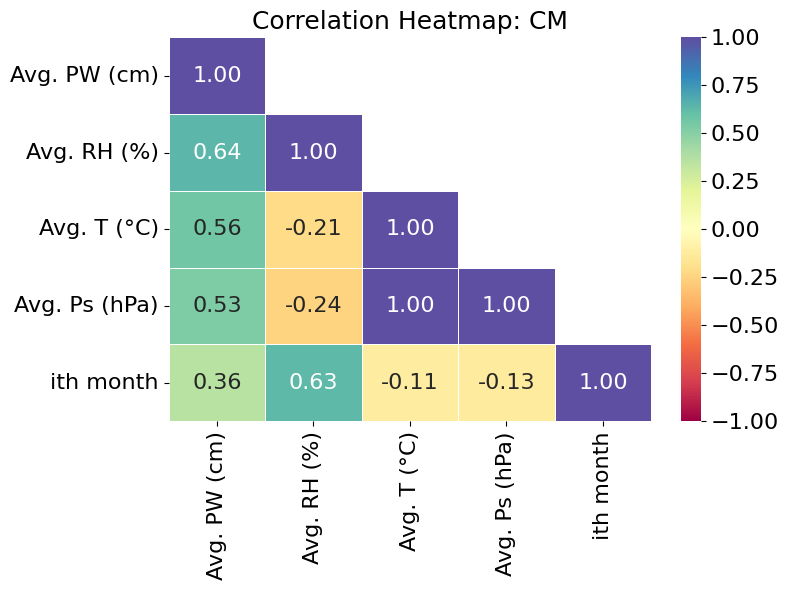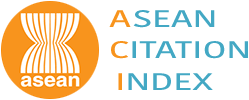Atmospheric Precipitable Water Estimation from Long-Term Ground-Based Meteorological Data using Artificial Neural Network Model
Keywords:
ANN model, atmospheric precipitable water, atmospheric precipitable water estimationAbstract
Background and Objectives: Water is one of the constituents of the atmosphere, being abundant at the surface and in small quantities in the stratosphere. Generally, atmospheric water vapor exists in solid, liquid, and gaseous states. The gaseous state known as water vapor is important to the physical, chemical, and various processes that occur in the atmosphere, such as its ability to absorb solar radiation transmitted to the earth, its ability to absorb infrared radiation emitted from the earth, its role in the size and composition of hygroscopic aerosol particles, affecting the optical properties of aerosols, and being naturally occurring greenhouse gas, and etc. Furthermore, atmospheric water vapor is vital for the formation of cloud and rain, as it can remove dissolved gases and aerosols from the atmosphere. It is also important for energy transformation processes in the atmosphere between continents and oceans for regional or climate-sensitive radiation balance. Therefore, the amount of atmospheric water vapor is a key variable for hydrology, ecosystem, climate, and global climate change. Thus, it is necessary to monitor, measure and study the changes in the amount of atmospheric water. Atmospheric water content can be expressed in several forms, such as absolute humidity, relative humidity, specific humidity, mass mixing ratio, volume mixing ratio, and total precipitable water in the atmospheric column, and etc. These quantities are derived from direct measurements using instruments or indirect methods employing models or calculations from other variables. Currently, instruments for measuring atmospheric water content remain expensive, leading to limited and discontinuous measurement coverage. Consequently, the objective of this study is to estimate monthly average atmospheric water from long-term ground-based meteorological data using Artificial Neural Network (ANN).
Methodology: The study area was defined as three locations with continuous measurement of atmospheric water and ground-based meteorological data: the northern meteorological center, Chiang Mai province (18.98N, 98.98E); the northeastern meteorological center (lower part), Ubon Ratchathani province (15.25N, 104.87E); and the southern-east coast meteorological center, Songkhla province (7.20N, 100.60E). The data utilized for the study, covering the period 2008 – 2024, include: (1) Monthly average TPW measured by ground-based sunphotometer of the Aerosol Robotic Network (AERONET), National Aeronautics and Space Administration (NASA); (2) daily average ground-level ambient air temperature measured by the Thai Meteorological Department (TMD); (3) daily average ground-level ambient air relative humidity measured by the TMD; (4) monthly average saturated water vapor pressure calculated from the Improved Magnus Formula using monthly average ground-level ambient air temperatures and relative humidity; and (5) month of the year (as an ordinal variable). The daily average ground-level ambient air temperature and relative humidity with more than or equal to 15 days/month were averaged to be used as the monthly average of that month, while months with less than 15 days/month of such data were not considered. The relationship between input and output variables and between input variables were then analyzed using the Pearson correlation coefficient (or Pearson product-moment correlation coefficient, r) via Python programming language through Google Colaboratory. Data from 2008 – 2021 were used for model development and data from 2022 – 2024 for model testing using the WEKA software. Finally, the model performance was evaluated with the Mean Bias Error (MBE), Root Mean Squared Error (RMSE), and coefficient of determination (R2) in Microsoft Excel.
Main Results: The analysis of the relationship between the input variables (monthly average ground-level ambient air temperature, monthly average ground-level ambient air relative humidity, monthly average saturated water vapor pressure, and month of the year (as an ordinal variable) and the output variables (monthly average TPW) showed that the Pearson correlation coefficients at Chiang Mai, Ubon Ratchathani, and Songkhla stations were in the range of 0.36 – 0.64, 0.29 – 0.52, and 0.17 – 0.44, respectively. This result showed that the input and output variables were a weak to moderate positive relationship. Moreover, the relationship between input variables also were a weak to moderate positive and negative relationship. The results of ANN model derived from these relationship levels showed that each station had 2 hidden layers. The number of nodes in the hidden layers were 5 and 2 for Chiang Mai, 8 and 5 for Ubon Ratchathani, and 8 and 5 for Songkhla. The results of the model performance evaluation of these stations found that the model can estimate the monthly average atmospheric water content with accuracy of MBE values of -0.89%, -1.23%, and 1.04%, respectively, RMSE values of 4.21%, 4.85%, and 5.34%, respectively, and R2 values of 0.98, 0.95, and 0.81, respectively.
Conclusions: From the atmospheric water content estimation using the ANN model, it was found that the overall MBE, RMSE, and R2 were -0.39%, 4.83%, and 0.95, respectively. The results of the study showed that, despite low to moderate correlation between variables, the utilization of long-term data allows the proposed model to estimate the monthly average atmospheric water content with high level of accuracy compared to other similar studies (in terms of location and variables).
References
Adeyemi, B. (2009). Empirical Formulations for Inter-Layer Precipitable Water Vapor in Nigeria. Asia-Pacific Journal of Science and Technology, 10(2), 35-45.
Alduchov, O. A., & Eskridge, R. E. (1996). Improved Magnus form Approximation of Saturation Vapor Pressure. Journal of Applied Meteorology. 35(4), 601-609.
Azadi, S., & Sepaskhah, A. R. (2012). Annual Precipitation Forecast for West, Southwest, and South Provinces of Iran using Artificial Neural Networks. Theoretical and applied climatology, 109, 175-189.
Buntoung, S., Pariyothon, J., & Detkhon, P. (2021). Estimation of Atmospheric Precipitable Water in Thailand using an Artificial Neural Network. Asian Health, Science and Technology Reports, 29(2), 11-20.
Buntoung, S. (2022). Introduction to Atmospheric Physics (1st ed). Thailand: Silpakorn University. (in Thai)
Frank, E., Hall, M. A., & Witten, I. H. (2016). The WEKA Workbench - Data Mining: Practical Machine Learning Tools and Techniques. UAS: Morgan Kaufmann.
Du, Z., Yao, Y., Zhang, B., & Zhao, Q. (2024). Precipitable Water Vapor Estimation from Himawari-8/AHI Observations using a Stacking Machine Learning Model. Atmospheric Research, 301, 107281.
Holben, B. N., Eck, T. F., Slutsker, I. A., Tanre, D., Buis, J. P., Setzer, A., Vermote, E., Reagan, J. A., Kaufman, Y. J., Nakajima, J., Lavenu, F., Jnnkowiak, I., & Smirnov, A. (1998). AERONET—A federated Instrument Network and Data Archive for Aerosol Characterization. Remote sensing of environment, 66(1), 1-16.
Janjai, S. (2017). Solar Radiation (2nd ed). Thailand: Phetkasem Printing Group. (in Thai)
Kämpfer, N. (2013). Monitoring Atmospheric Water Vapour, Ground-Based Remote Sensing and In-situ Methods. USA: Springer.
Kongara, V. S., & Punyasesudu, D. (2015). Forecasting the Water Vapour Distribution Over India using Artificial Neural Networks. International Journal of Advanced Research in Computer Engineering & Technology (IJARCET), 3(4), 1-12.
Kumar, A., Kumar, S., Pratap, V., & Singh, A. K. (2021). Performance of Water Vapour Retrieval from MODIS and ECMWF and Their Validation with Ground Based GPS Measurements over Varanasi. Journal of Earth System Science, 130, 1-11.
Liu, J., Sun, Z., Liang, H., Xu, X., & Wu, P. (2005). Precipitable Water Vapor on the Tibetan Plateau Estimated by GPS, Water Vapor Radiometer, Radiosonde, and Numerical Weather Prediction Analysis and Its Impact on the Radiation Budget. Journal of Geophysical Research: Atmospheres, 110(D17).
Moustris, K. P., Larissi, I. K., Nastos, P. T., & Paliatsos, A. G. (2011). Precipitation Forecast using Artificial Neural Networks in Specific Regions of Greece. Water resources management, 25, 1979-1993.
Okulov, O., Ohvril, H., & Kivi, R. (2002). Atmospheric Precipitable Water in Estonia, 1990–2001. Boreal Environment Research, 7(3), 291.
Patterson, D. W. (1998). Artificial Neural Networks: Theory and Applications. New York: Prentice Hall PTR.
Phokate, S., & Atyotha, V. (2018). Determination of the Amount of Water Vapor in the Troposphere over Thailand using Surface Data. Kasem Bundit Engineering Journal, 8, 364-372.
Senkal, O., Yildiz, B. Y., Sahin, M., & Pestemalcı, V. (2012). Precipitable Water Modelling using Artificial Neural Network in Cukurova Region. Environmental Monitoring and Assessment, 184, 141-147.
Shanmuganathan, S. (2016). Artificial Neural Network Modelling: An Introduction. Switzerland: Springer International Publishing.
Sharma, S., Sharma, S., & Athaiya, A. (2017). Activation Functions in Neural Networks. Towards Data Science, 6(12), 310-316.
Schober, P., Boer, C., & Schwarte, L. A. (2018). Correlation Coefficients: Appropriate Use and Interpretation. Anesthesia & analgesia, 126(5), 1763-1768.
Szandała, T. (2021). Review and Comparison of Commonly Used Activation Functions for Deep Neural Networks. Bio-inspired Neurocomputing, 203-224.
Van Baelen, J., Aubagnac, J. P., & Dabas, A. (2005). Comparison of Near–Real Time Estimates of Integrated Water Vapor Derived with GPS, Radiosondes, and Microwave Radiometer. Journal of Atmospheric and Oceanic Technology, 22(2), 201-210.

Downloads
Published
How to Cite
Issue
Section
License
Copyright (c) 2025 Faculty of Science, Burapha University

This work is licensed under a Creative Commons Attribution-NonCommercial-NoDerivatives 4.0 International License.
Burapha Science Journal is licensed under a Creative Commons Attribution-NonCommercial-NoDerivatives 4.0 International (CC BY-NC-ND 4.0) licence, unless otherwise stated. Please read our Policies page for more information



